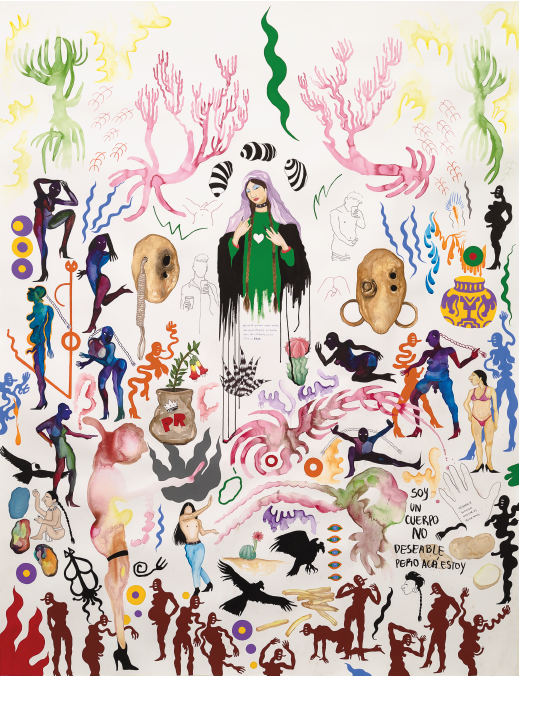About the exhibition
Large black circles by the artist Iara Freiberg intervene the façade of the Proa building and traverse the architecture, invading the interior space and creating suggestive volumes to the viewer's eye, putting into consideration the limits of the institution hosting the exhibition. Inside the galleries, it's Sergio Avello's Flag (2003) that welcomes us. "Created for the first time on the occasion of the Porto Alegre Biennial and in reference to the social and economic crisis of 2001, the intermittent switching on and off of the white and blue fluorescent tubes visually and masterfully synthesize the powerlessness, the cycles of 'on and off' that our country experiences. After twenty years, the work maintains the relevance of its statements," recalls Adriana Rosenberg, curator of the entry to the 2003 Biennial.
Analía Saban's pieces unveil the complex mechanism present in everyday objects; they confront us with images of incomprehensible circuits, provoking strangeness, astonishment, and amazement, generating the duality of the familiar and the hidden.
Economy, dissidence, identities, and censorship transcend the ensemble, in which the scale of Alicia Herrero's installation stands out. The work proposes to find the point that completes the vision of a statistical graph on the distribution of wealth, an abstraction of the global situation that, when extrapolated to the realm of a museum, takes on other symbolism: behind the percentages are thousands of human beings. In contrast, La Chola Poblete and Amparo Viau humanize these hard data by giving them a voice through exuberant mythological characters and iconographies of contemporary identity. That voice is also present in Mauro Giaconi's work, in this case as writing, a multitude of silenced words behind a wire fence. History, writing, and censorship.
The representation of nature in the work of the artist couple Dolores Zinny & Juan Maidagan alludes, in its variations of reddish, orange, yellow, and green, to the desertification of the humid pampas and the fires that occurred in the province of Santa Fe, their homeland, highlighting in its abstraction the problem of climate change. The sounds that surround us are visualized in the metal cone installed over a water circle in Juan Sorrentino's work, like a nature of its own where the swirl of water generates movement and sound in the exhibition room. The accompanying photographs show the same element in the landscape. Alan Martín Segal does the same in the video installation where, immersed in an intense green, sounds and dialogues in a city appear, another landscape that reconstructs the presence of violence and fear in large cities.
The materiality in contemporary artistic practice and the presence of painting today are appreciated in the remains of material that Silvia Gurfein rescues when constructing small oil sculptures and works on paper. The poetry present in the act of rescuing the remains of paint and turning them into art also proposes a journey through art history. In dialogue, the monochromatic frames moving through space by Mariela Scafati also twist from two to three dimensions, seeking to generate unprecedented spaces with the elements unique to art.
Andrés Aizicovich's piece combines history, voices, artisanal and industrial elements, inviting the viewer to speak and listen through communicating vessels in which the synchronicity between history and the present is perceived.
The sculptural space built with latex by the artist Elena Dahn gains meaning when inhabited. Being present and supported on the wall, it's the possible activations that transform the work and enhance the richness of the material, breaking the boundaries between the wall and the environment.
And it's Iara Freiberg's work that we occasionally encounter in the Proa journey, surprising with the disappearance of architectural limits, proposing new forms and spaces to inhabit once again through signages that combine virtuality, painting, craftsmanship, and graphics.
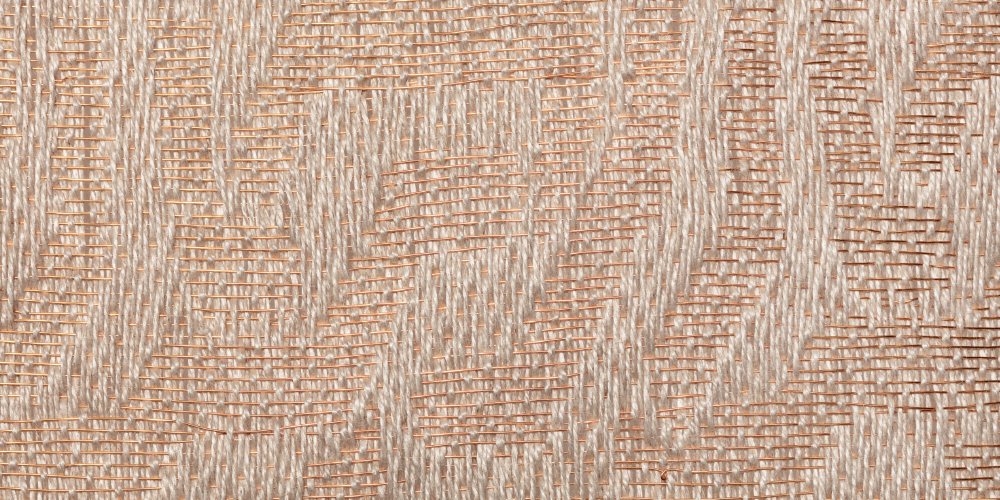
Interview with Rodrigo Alonso This interview was conducted by the Press Department of Fundación Proa.
What is the common thread or concept that threads the exhibition together?
The exhibition offers a journey through the work of a small group of contemporary Argentine artists. The selection doesn't follow a general theme but rather connects poetics, generating continuous dialogues and counterpoints. One of the starting points was related to the notion of "Argentine art" itself. We know that artists today are nomads and create in diverse contexts. Many of the artists included in this exhibition don't live in Argentina, either temporarily or permanently. Some maintain ties to their home country, while others do not. Could it be said that they create "Argentine art"? Furthermore, even those living and working in Argentina maintain connections with international art. After all, contemporary art is not a local invention. Is their art Argentine simply because it was created here? In summary, the exhibition seeks to challenge this key topic in the contemporary scene. Ultimately, the selected artworks offer a wide panorama of techniques and artistic resources that move between the formal, the conceptual, and the political. Some were created specifically for this exhibition, while others are presented in a different context. Although each piece was chosen for specific reasons - based on the interactions they could generate with their companions - the choice is somewhat arbitrary: they don't "represent" Argentine art any better than others, as that representation is in crisis.
How does the selection of artworks connect with the title of the exhibition?
The word "conjecture" has to do with supposing, proposing a hypothesis. The conjecture here - and this goes a bit against everything said earlier - is that within this collection, there is a manifestation of Argentine art. Presenting this conjecturally also means that there's no certainty, and the question is left open for thinking and discussion with the viewer.
Local circumstances appear in the chosen pieces: the promise of a country that never quite takes off, poverty, dissidences (gender issues, identity, indigenous peoples)... Does this tension the hypothesis that there is no 'Argentine' in Argentine art?
Actually, the idea isn't that there's no "Argentine" in Argentine art, but rather that the concept of Argentine art is a topic to be debated, to be tensed. Starting the exhibition with Sergio Avello's Argentine flag is a kind of provocation; it's obviously a work that references our country. But Avello conceived it as a flag that never stabilizes, meaning he also put the signifier of "the Argentine" in his work under tension. On the other hand, it's true that there are themes that can be Argentine, but we should ask ourselves if that's enough for a work to qualify as Argentine art. There's little reflection on forms, aesthetic tools, languages. Conceptualism, video installation, technological art are resources constructed or developed elsewhere, which, while adopted in our country and reworked with a unique sense, remain transnational elements with logic linked to a global semantic field. There's nothing autochthonous about them. The same goes for agendas. The exhibition includes pieces that address gender issues, dissidences, etc., but these agendas are also global, even though we might adopt them from a local perspective.
Regarding the multidisciplinary nature of the curatorial criteria, do the selected techniques and formats align with current artistic production worldwide?
Yes, completely. As I mentioned, they are the techniques and formats of global contemporary art. They are the lingua franca that paradoxically allows local singularities to be read in a contemporary artwork. The exhibition consists of a multitude of techniques and formats, from the most traditional to the newest, from drawing, painting, or textiles to video installation, sound works, and performance.
The exhibition coincides with the upcoming edition of Cimam in Buenos Aires. How was this international event considered in the curatorial decisions?
The exhibition has a much longer duration than the Cimam event, so it's also designed to be appealing to the audience of Fundación Proa, with educational support and public programs that allow contemporary Argentine art to be brought closer to a wide audience. The next Cimam edition primarily influenced the project itself. Knowing that curators and directors of modern and contemporary art museums from around the world would be visiting, we thought it was important to offer them a brief overview of contemporary local productions. But at the same time, knowing that many museums and cultural spaces could adopt a similar strategy, we decided to organize an exhibition with a small number of artists, giving each of the selected artists the opportunity to showcase their work in the best possible way.
Interview with Adriana Rosenberg
This interview was conducted by the Press Department of Fundación Proa.
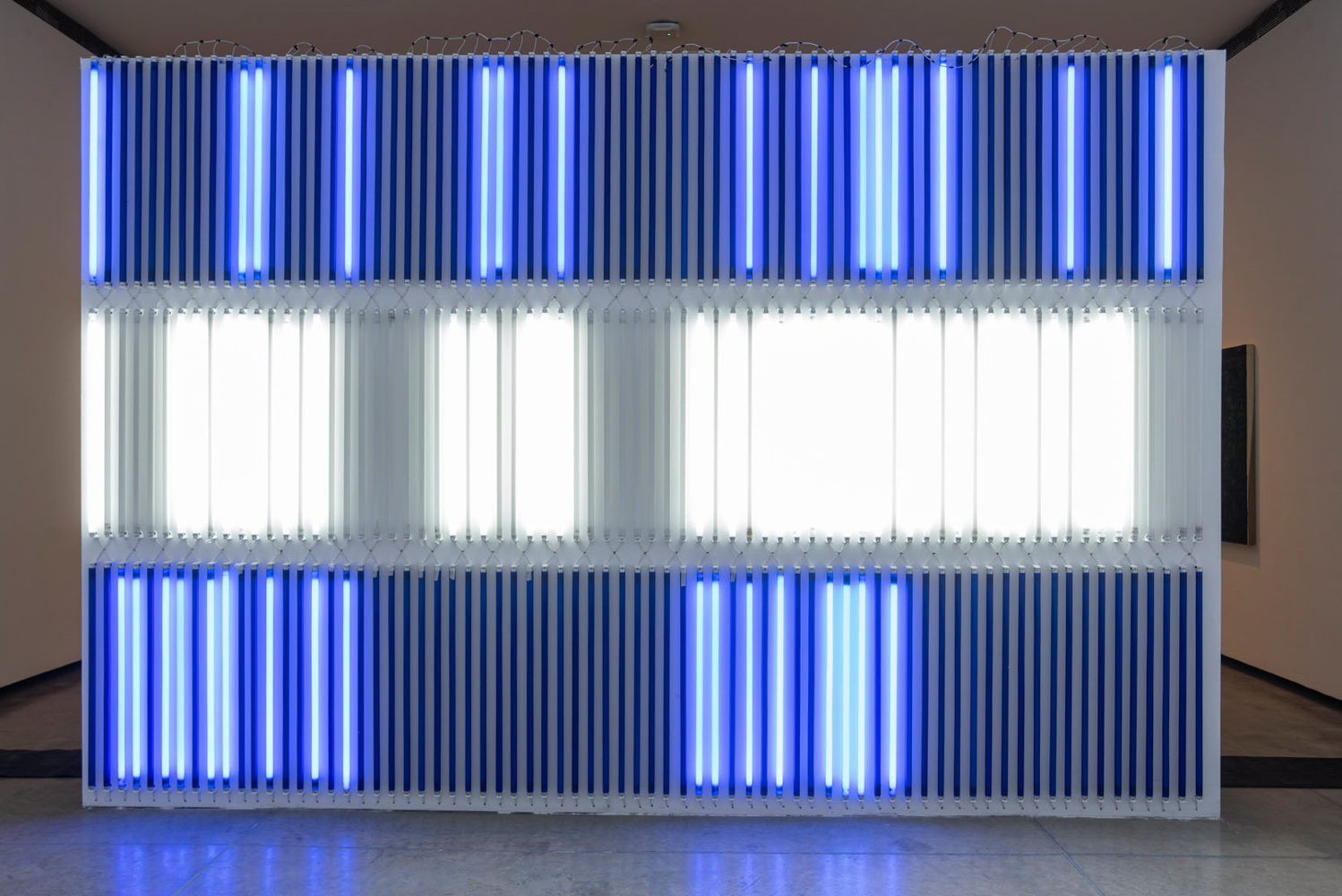
Why does Proa decide to present "Conjectures," an exhibition focused on Argentine art?
We are involved in two important events: one is the upcoming Arteba art fair that coincides with the opening of the exhibition, and the other is the collaboration with Cimam (Annual Conference of the International Committee for Museums of Modern Art), which is taking place in Buenos Aires in November for the first time. In agreement with other local institutions, we all decided to showcase the Argentine art scene. After analyzing the proposals from the institutions, we found it interesting to highlight the presence of Argentine artists living abroad, in different countries and cultures ranging from the United States to Berlin and Mexico, and present their work alongside that of artists based here. This working hypothesis is the result of various questions as highlighted by curator Rodrigo Alonso when he questions the idea of Argentinity, the scope of global culture, artistic practice, the influence of the local, etc. This series of questions made us realize that, more than answers, the value lies in the question itself. "Conjectures" encompasses this issue.
What conjecture does Proa make (in this exhibition) regarding contemporary Argentine art?
The idea of conjecture arose in conversations with Rodrigo Alonso and during the development of the proposal, as we questioned the concept of Argentinity that is being showcased in connection with the upcoming events in Buenos Aires. We invited artists whose work we found interesting, leaving it somewhat to chance because we were interested in the artist's presence here, with their work and their questions to be answered collectively in the activities of the public program that we developed as a complementary tool to the exhibition.
And are the artists coming?
Yes, Mauro Giaconi who lives in Mexico will be present, as will Alan Martín Segal who is in New York. We will also have the presence of Dolores Zinny and Juan Maidagán, who will arrive later.
Currently, is the notion of country, homeland, and "Argentinity" present in the artists' work?
It's a question, hence it cannot be definitively answered. Today we find artists from various origins representing countries that are not their own, as will happen at the upcoming Venice Biennale where Peruvian artist Sandra Gamarra - who participated in "El Dorado," the exhibition that inaugurated Proa's 2023 calendar - will represent Spain. Global culture erases borders, and artists draw from that diaspora, both physically and virtually. Not only the artists but also the audience. In an era where information is spread on the internet without specifying who wrote or created an image, the notion of origin changes. Genetics says it's important... and what about culture? These are many of the issues we are considering. With no clear answers, we thought it better to pose these questions. Hence "Conjectures"...
But there are works like "Bandera" (Flag) by Sergio Avello, which is profoundly local.
Exactly. "Bandera" is a perfect example of that duality. But like all works of art, while it reconstructs the colors of the Argentine flag, it's the intermittency that suggests the economic and social problems present in many countries. Hence, it resonates as a metaphor for a historical moment.
How does 'the Argentine' make itself felt, apart from the fact that the artists were born here?
From Proa's perspective, we consider the need to be connected and in dialogue with the context. We did this in the "Laberintos" exhibition, where we accounted for the 'labyrinthine' time of the situation. We also presented "El Dorado," which led us to think and question the return to origins. We felt that we are currently going through a situation of immense conjecture, and that puts the viewer in a special position of questioning and uncertainty, with no certainties about the future.
What local themes do the selected works address or suggest?
I think what's interesting about this exhibition is that it reflects a global agenda and brings together many viewpoints. In its development, Rodrigo connected various themes. The first is the concept of how technology enters our lives, and the works of Avello and Saban confront us with that dilemma. Both connect with Alicia Herrero's piece because what we see in it are images created with technological tools, graphics that are absolutely familiar and appear daily in the media – an abstraction that gains meaning when read in the present context. The exhibition takes the viewer through different situations, and the curator's proposal is very apt, closing with works whose materiality relates to the problem of painting itself.
Gallery 1
Contemporary art is a globalized system that establishes certain ways of doing and saying in the realm of aesthetic sensitivity. Due to this, productions carried out in various contexts and geographies can coexist within a circuit of exhibitions, institutions, and shared agents. Paradoxically, this system promotes the creation of unique, subjective, localized works, but always within a vocabulary of more or less standardized practices and forms, accessible to an international (Western) perspective.
Within this framework, is it possible to speak of contemporary Argentine art? To what extent do the works produced in our country fit into this category? And what about productions created by Argentine artists who, for some reason, don't reside in our territory? Could we identify a collection of works or authors that represent "Argentineness"? What meaning does any representation hold in a world of cultural values, social structures, political ideologies, and fluid identities?
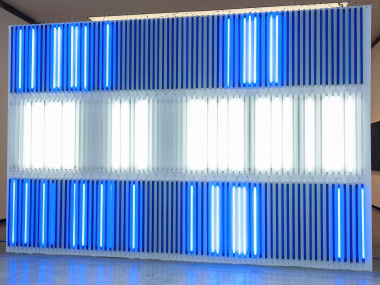 Sergio Avello. Bandera, 2003/2023. Tubos de luz y microprocesador. 276 x 608 cm. Cortesía familia Avello y Museo de Arte Moderno de Buenos Aires
Sergio Avello. Bandera, 2003/2023. Tubos de luz y microprocesador. 276 x 608 cm. Cortesía familia Avello y Museo de Arte Moderno de Buenos Aires
Sergio Avello
The multifaceted artist Sergio Avello (Mar del Plata, 1964-2010) developed a prolific body of work from the 1980s until his death, characterized and distinguished by his unique universe. Starting from his beginnings in 1984, he showed a continuous interest in abstraction, which persisted in his later works. The use of color and light is materialized in the Flag that initiates the exhibition journey of "Conjectures," alongside the installation by Iara Freiberg. His interest in national symbols arose as a response to the Argentine crisis of 2001, a turbulent period that was reflected in many artists of the local scene, who were also friends of Sergio. His commitment transcended political and economic matters, showcasing a strong advocacy for the LGBTQ+ community.
Originally presented within the framework of the Mercosur Biennial in 2003, the artwork consists of three strips of blue and light blue fluorescent tubes that flicker on and off in an apparently erratic choreography. The intentional synchronization of these lights was developed by the artist using software that processed and sent the timing for each flicker. This mechanism is systematically repeated until it configures the Argentine flag – with the exception of the sun – in its entirety, an effect that quickly reverses, reflecting the country's instability.
The artwork was conceived during the 6th Mercosur Biennial in 2003. Since then, it has been reissued for Estudio Abierto Centro (2006), the Museum of Modern Art in Buenos Aires (2017), and the Proa Foundation (2023).
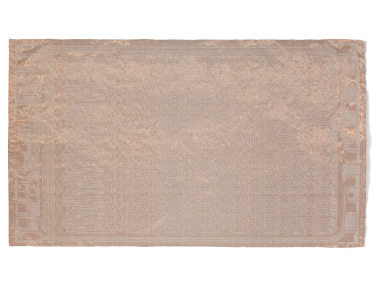 Analía Sabán. Copper Tapestry (256-Bit Static Ram, 4100, Fairchild, 1970), 2020. Alambre de cobre e hilo de lino. 308,6 x 181 x 2 cm. Cortesía de la artista y Sprüth Magers
Analía Sabán. Copper Tapestry (256-Bit Static Ram, 4100, Fairchild, 1970), 2020. Alambre de cobre e hilo de lino. 308,6 x 181 x 2 cm. Cortesía de la artista y Sprüth Magers
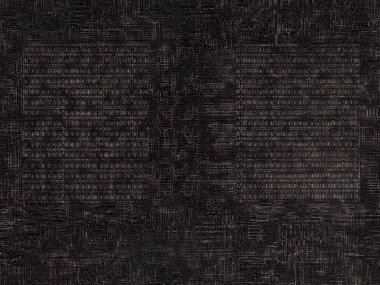 Analía Saban. Pleated Ink (Erasable Programmable Read -Only Memory, Intel 1702,1971),2020. Papel grabado con láser sobre tinta. 116,8 x 162,6 x 5,4 cm. Cortesía de la
Analía Saban. Pleated Ink (Erasable Programmable Read -Only Memory, Intel 1702,1971),2020. Papel grabado con láser sobre tinta. 116,8 x 162,6 x 5,4 cm. Cortesía de la
Analía Saban
One of the main themes explored by Analía Sabán (Buenos Aires, 1980) is the dialogue between technological development and textiles in relation to longevity over time. To achieve this, she employs unconventional methods by interweaving images of computer circuits with the handcrafted machine weaving of textiles.
In her tapestry titled "Copper Tapestry (256-Bit Static Ram, 4100, Fairchild, 1970)," created using copper, she uses the structure of microchips as a matrix, representing the foundation of a pattern that is woven through a computer-programmed loom. The juxtaposition of weaving and the architecture of the represented technology offers a critical perspective on the supposed distinctions between analog and digital realms. In "Pleated Ink," she takes various designs of historically significant microchip circuits, many of which are already obsolete, and uses laser-cut paper templates covered with black ink. Over the course of several months, the ink doesn't completely dry, resulting in folds and wrinkles on these surfaces. The titles of her works often reference specific types of technologies, such as dynamic random-access memory (DRAM) or particular memory microprocessors from Intel.
In the artist's own words: "I grew up in that world, visiting my uncle's businesses, surrounded by textiles. I love seeing fabrics and their different textures. In a way, what happens in the world, in society, is reflected in textiles: globalization, commerce, humanitarian issues. It's amazing how a piece of clothing, the material itself, whether it's cotton, synthetic, handmade, or factory-made, can tell you so much about industrial and social matters. The same thing happens in art, for example with acrylic or oil painting. I've always been interested in that basic level of a material, that observation which combined with my interest in mathematics and computing, because weaving also originates from a binary system that results in a super complex pattern."
Gallery 2
Through an analysis of statistical representation systems, Alicia Herrero constructs geometric abstractions laden with economic and political connotations. In her planes and color variations, deep conflicts and inequalities are symbolized, stemming from an increasingly savage capitalism that seems to have found in this type of representation the ideal means to account for its effects in a distant and dispassionate manner.
In contrast, the works of Amparo Viau and La Chola Poblete give free rein to the bodies that these abstractions elude, confronting the reduction of human beings to numbers with the excess of figures brimming with singularity. Viau presents a coven of human and non-human entities engaged in polyamorous, playful, and sensual activity. Their energy extends into an exalted and vibrant chromatic palette. La Chola Poblete confronts the colonizing gaze in watercolors where virgins and dissenting beings take center stage, around whom situations and characters unfold, situated midway between political commentary and autobiographical reference.
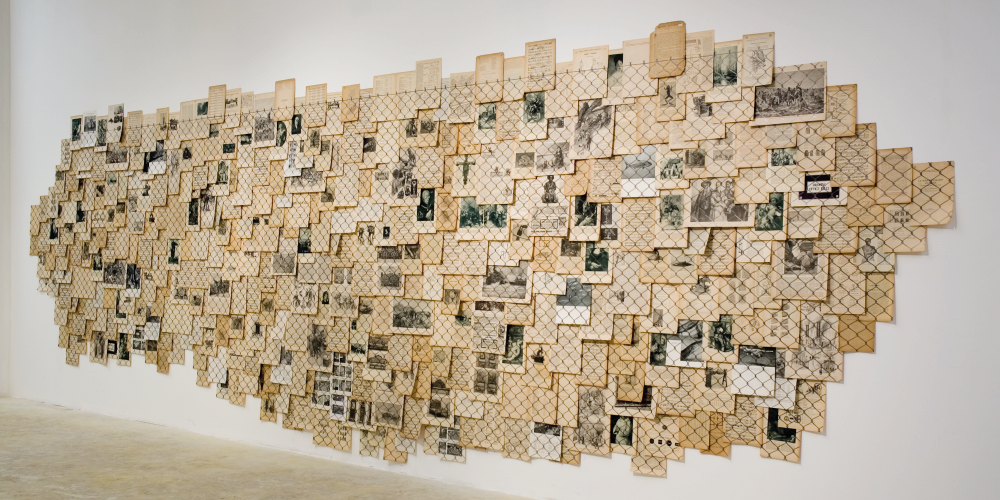
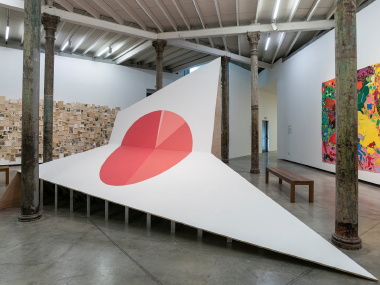 Alicia Herrero. Abducción, 2023. Madera, metal, pintura. 700 x 700 x 400 cm. Cortesía de la artista y Herlitzka+Faria
Alicia Herrero. Abducción, 2023. Madera, metal, pintura. 700 x 700 x 400 cm. Cortesía de la artista y Herlitzka+Faria
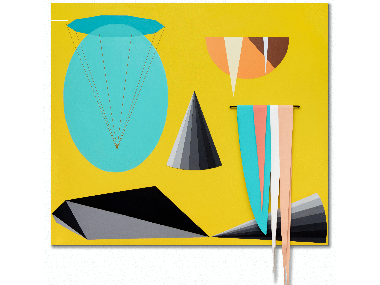 Alicia Herrero. Vanitas, 2021-2022. Acrílico, madera, lienzo, acero. 175 x 200 x 9 cm. Cortesía de la artista y Herlitzka&Co.
Alicia Herrero. Vanitas, 2021-2022. Acrílico, madera, lienzo, acero. 175 x 200 x 9 cm. Cortesía de la artista y Herlitzka&Co.
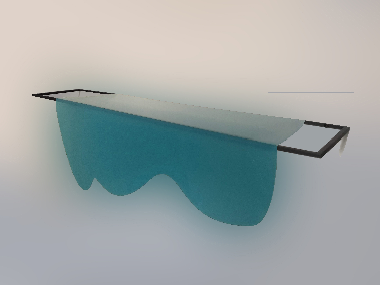 Alicia Herrero. Evasión, 2018. Escultura, acrílico y metal. 28,5 x 100 x 17,5 cm. Cortesía de la artista y Herlitzka&Co.
Alicia Herrero. Evasión, 2018. Escultura, acrílico y metal. 28,5 x 100 x 17,5 cm. Cortesía de la artista y Herlitzka&Co.
Alicia Herrero
The work of Alicia Herrero (Buenos Aires, 1954) engages a critical-sensitive repertoire of new aesthetics that both challenge the substantial values of our culture and explore the unsuspected reaches of art.
At the center of the room stands a monumental installation titled Abduction, a work that inaugurates different modes of spatial perception and invites us to experience the limits and dislocations of our conventions and viewpoints. It is a large-scale pie chart that expands over an inclined solid wooden platform. As you move around it, it offers different perspectives on the distribution of global income in the year 2020. Constructed through inclined planes and the technique of anamorphosis, it presents this graphic representation of global social and economic inequality, which can only be seen in its entirety from a specific viewpoint in space. This condition actively involves the body and the movement of exhibition visitors, prompting them to experience the performative practice of constructing and deconstructing shapes and space.
Vanitas and Evasion are works that are part of an extensive series that she has been working on since 2015. These abstract images propose a critical-sensitive repertoire in the way of perceiving various inequalities and in the way of opening up a world based on their own scope. These are pieces that investigate the intersection of genres and materialities within art, architecture, and corporate grammars.
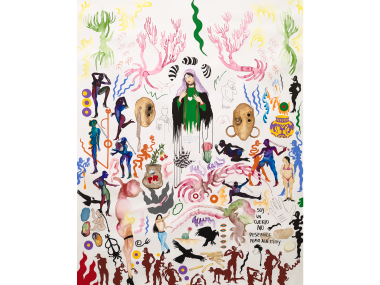 La Chola Poblete. Virgen gótica, de la serie Vírgenes Cholas, 2022. Acuarela y tinta sobre papel. 198 x 153 cm. Colección privada
La Chola Poblete. Virgen gótica, de la serie Vírgenes Cholas, 2022. Acuarela y tinta sobre papel. 198 x 153 cm. Colección privada
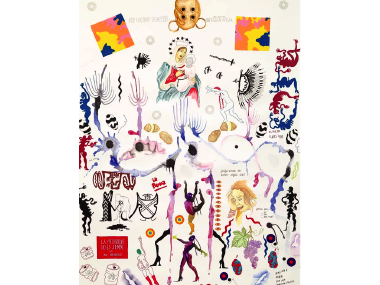 La Chola Poblete. La virgen del Rosario, de la serie Vírgenes Cholas, 2022. Acuarela y tinta sobre papel. 198 x 153 cm. Colección privada
La Chola Poblete. La virgen del Rosario, de la serie Vírgenes Cholas, 2022. Acuarela y tinta sobre papel. 198 x 153 cm. Colección privada
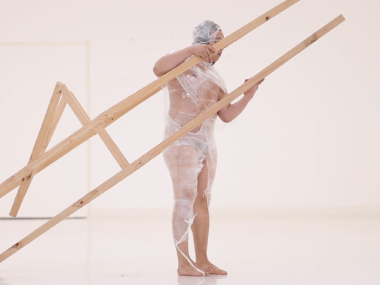 La Chola Poblete. Muerte de barro, 2020. Videoperformance. 7 11. Cortesía de la artista y Pasto Galería
La Chola Poblete. Muerte de barro, 2020. Videoperformance. 7 11. Cortesía de la artista y Pasto Galería
La Chola Poblete
To address the dilemmas of her mixed heritage, La Chola Poblete (Mendoza, 1989) employs various mediums and resources in the creation of original images that bring together elements of diverse nature. Contrary to stereotypes, she reclaims ancestral knowledge and exposes colonial practices of racial and gender discrimination. Her voice emerges from sexual and skin color dissidences, in alignment with the Brown Identity collective. In her work, there's a pursuit of the body where experimentation and performance are key resources. She utilizes the figure of the "chola" to reclaim non-hegemonic beauty and stimulate the desire for transformation.
The series of "virgenes cholas" consists of 33 pieces, where the figure of the virgin is the central element. In her own words, she has always been captivated by this motif: "I've always been drawn to the image of that woman, how she's constructed and how she intrudes upon our territory and our history. The images that accompany these figures create a narrative, a story. It's as if they were songs, as if each element were a word." She conceives these compositions as songs inspired by different elements she observes in her daily surroundings: potatoes, overflowing stains, noses, shoes, phrases, graffiti, and more.
The significance of working with the body can be seen in the video performance Muerte de barro (2020), which documents a wooden structure resembling a coffin that encases and interacts with the artist's body wrapped in transparent plastic.
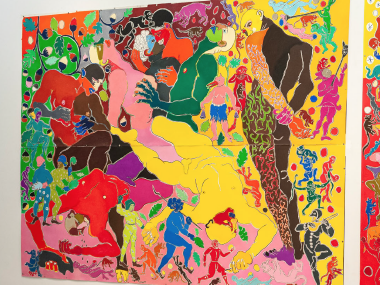 Amparo Viau. Umarell, 2023. Detalle. Tiza pastel sobre papel. 430 x 500 cm. Cortesía de la artista y Galería Grasa
Amparo Viau. Umarell, 2023. Detalle. Tiza pastel sobre papel. 430 x 500 cm. Cortesía de la artista y Galería Grasa
Amparo Viau
In her monumental paintings, Amparo Viau (Buenos Aires, 1991) approaches interwoven imaginary universes of characters with an original pictorial and iconographic sensitivity. A constant in her works is the connection established among different characters through their gazes, accentuating a play of movements amid bold lines and vibrant colors.
The title of this artwork, Umarell, refers to a term in the Bolognese dialect, which pertains to older men who spend a lot of time observing construction sites, especially those related to roadworks. Stereotypically, they stand with their hands crossed behind their backs, offering unsolicited advice and opinions about what they see. The term's literal meaning is "little man" or "little guy." The artist describes this composition in the following words: "Little men with a penchant for observing and giving unwanted advice. The main character stands with hands on their back, observing the other bodies in the composition. A grand scene filled with inward dramatic tensions through a play of gazes among the characters, which also serve as distinct focal points of attention. Amid the monumental figures that establish the primary, almost melodramatic, drama, small figures depict more absurd medieval scenes, contextualizing the artwork."
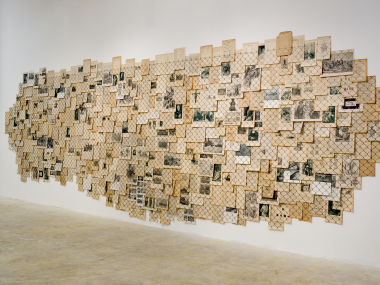 Mauro Giaconi. bres del mun- (antes Mural Alambrado), 2008. Dibujo sobre 500 páginas de libros diversos comprados por kilo. 800 x 300 cm.Colección del artista
Mauro Giaconi. bres del mun- (antes Mural Alambrado), 2008. Dibujo sobre 500 páginas de libros diversos comprados por kilo. 800 x 300 cm.Colección del artista
Mauro Giaconi
Mauro Giaconi (Buenos Aires, 1977) has been living and working in Mexico City since 2011. In his work, he primarily explores the tension between the real and the apparent, history and fiction, precarity and stability, through drawing and sculpture. Giaconi's artwork proposes a palimpsest of references and materialities that typically come together in drawings, sculptures, and installations, rupturing both our perspective and our environment. He intervenes in everyday objects, architectural spaces, and graphic archives, altering the visual and cultural assumptions of the images and things around us.
bres del mun- (formerly "Mural Alambrado") is a piece comprised of 500 drawings that meticulously depict a wire mesh. These drawings are manually rendered with graphite pencil on 500 selected pages from various books, mostly acquired by the kilo. The intervened pages, arranged without any specific order, are staggered on the wall, aligning the drawings and completing the life-size image of a metal wire fence or cyclone fence.
For this exhibition, Giaconi updated the title of the artwork, including a literal excerpt of text copied from one of the pages that make up this drawing, particularly from a copy of the score of the Argentine National Anthem. In the score, the lyrics are fragmented into syllables to match the melody. The selection refers to the phrase: "And the free people of the world respond."
In the artist's words: "The drawing process involved making the wire mesh the same size. When these layers are staggered, the drawings align, forming the mesh. It's graphite pencil on paper, that's the technique, and in the drawing, one of the things that interests me is to suggest distances or layers as the viewer approaches the image. I'm interested in that aspect where from a distance, it might seem like an object, and you realize it's a wire mesh, but when you get closer, you see the imperfection of the hand-drawn lines. There's a sense of temporality that becomes apparent when you recognize it's hand-made."
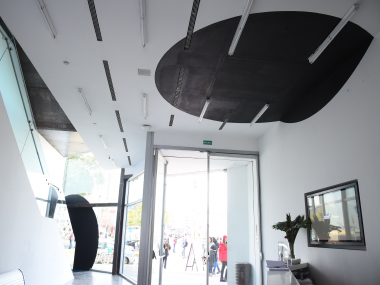 Iara Freiberg. Ausencia, 2023. Intervención en arquitectura. Dimensiones variables. Colección de la artista
Iara Freiberg. Ausencia, 2023. Intervención en arquitectura. Dimensiones variables. Colección de la artista
Iara Freiberg
The creation of interventions intrinsically linked to architecture is a central aspect of Iara Freiberg's work (Argentina - Brazil, 1977), who pursues her artistic career between Buenos Aires and São Paulo, investigating physical spaces, their designs, uses, and their relationships with the human body.
In Absences, large forms emerge on the imprecise border between inside and outside. Occupying the glass facade, they project inwards, visible from within. They are both space and landscape simultaneously. The characters are two large spheres, floating entities or celestial bodies that emerge in space and traverse the building. Formed by a delicate skin that covers the architectural structure, each one becomes "embodied" in the materiality of the construction, mimicking its features while also generating a void that absorbs everything. Through this body-less surface, spatially projected virtual volumes are created. The shadows of potential unattainable bodies, black holes exert forces upon each other, magnetizing the space.Gallery 3
Urban landscape, nature, sound, and fiction are some of the focal points of this exhibition room. Dolores Zinny & Juan Maidagán construct a device composed of overlapping windows that, in reality, serve as the canvas for a visual narrative. Their hues reference the field fires in Rosario, the hometown of the artists; the reflections, perhaps, bring the fiery inferno into the present. The geometric harmony is disrupted as it takes on an alien, spurious meaning. Slowly, drama tinges the structure that, at first glance, appears splendid and rational.
Juan Sorrentino's work is characterized by his exploration in the realm of sound. The pieces presented here delve into the relationship between sound and vibration. Temblor shakes the walls of the institution through seismic agitation produced by speakers emitting an inaudible frequency. Escáner espacial is an object that modulates its surroundings through the diffusion of white noise. In both projects, this immaterial action unveils unnoticed aspects of our surroundings, revealing hidden events that exist beyond our perception.
Alan Martín Segal's video is presented as an emotional landscape of Buenos Aires, a city torn between an assumed glorious past with European affiliations and an urgent, problematic present that hinders its projection into the future. The narrative draws from ideas in Ezequiel Martínez Estrada's book La cabeza de Goliat. Through small sculptural impulses, animations, audiovisual records, and meticulously crafted sound design, the artist creates a portrait of the capital city immersed in a failed postcolonialism, trapped in a psychological loop from which it cannot escape.
 Juan Sorrentino. Space scanner, 2022. Cono de acero inoxidable, balsa de madera, estanque de hierro, agua, parlantes, sistema de audio, ruido blanco y bomba de agua. Dimensiones variables. Colección del artista
Juan Sorrentino. Space scanner, 2022. Cono de acero inoxidable, balsa de madera, estanque de hierro, agua, parlantes, sistema de audio, ruido blanco y bomba de agua. Dimensiones variables. Colección del artista
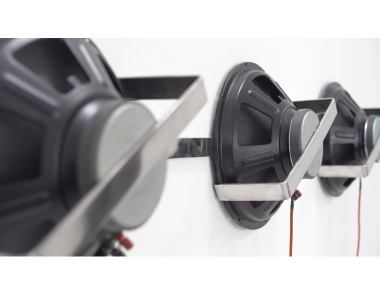 Juan Sorrentino. Tremor, 2022 (Temblor). 3 frecuencias sísmicas de 3 Hz, acero inoxidable, 3 parlantes, 3 amplificadores, 3 osciladores y cables. 40 × 280 × 30 cm. Colección del artista
Juan Sorrentino. Tremor, 2022 (Temblor). 3 frecuencias sísmicas de 3 Hz, acero inoxidable, 3 parlantes, 3 amplificadores, 3 osciladores y cables. 40 × 280 × 30 cm. Colección del artista
Juan Sorrentino
Space scanner, 2022
Tremor, 2022 (Temblor)
Artist Juan Sorrentino (Chaco, Argentina, 1978) explores the concepts of sound language in a poetic and collective imaginative context through his installations. The installation positioned at the center of the room, Space Scanner, consists of a floating metal cone rotating over a water tank. The piece emits a white noise sound - commonly used in acoustic measurements to gauge spaces and understand how they respond to frequencies - which is projected onto the surrounding surfaces: "The viewer hears the sound differently based on how it bounces off the objects around it," Sorrentino explains.
On the wall, three speakers surrounded by a strip of stainless steel release accumulated energy in the form of seismic waves at 3 Hz; this vibration, outside the audible range for humans and with a slight time delay, is visually manifested in their membranes. A sonic piece that, despite not producing sound, is visually translated into vibration. The arrangement of cables and aluminum tubes comprising the Tremor piece's device evokes an aesthetic associated with rock music.
Space Scanner was exhibited in "Music as Epiphany of the World," Herlitzka & Co (2022); VIC Aveiro Festival, Portugal (2018); "In the Wilderness, You're Never Alone," MONTE Residency, Chaco (2017); Lisbon SOA Festival, Portugal (2017).
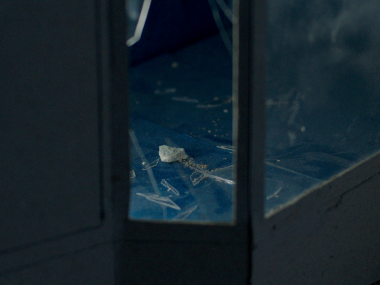 Alan Martín Segal. Falso Sport, 2023. Videoinstalación. 6 35. Colección del artista
Alan Martín Segal. Falso Sport, 2023. Videoinstalación. 6 35. Colección del artista
Alan Martín Segal
Alan Martín Segal (Buenos Aires, 1985), an artist and filmmaker, studies and analyzes cinematic language in his creative process; its animation techniques, recreations, so-called faux conceptualism, elements of sound art, and writing - to name a few. In the video installation Falso sport (False Sport), the artist articulates through a series of visual games certain repetitions, gestures, and images that highlight the editing process in cinema. His insistence on revealing the artificiality of the images takes form in cardboard models made by himself, deliberately and precariously realistic. An attempt to make visible a certain power dynamic that determines what is shared and what is silenced.
"A ghostly presence circulates through the videos, as if the trauma of an inherited culture, of an imposed logic, settles into a usage of cinematic language that I like to think of as perverse. The animations, within the lineage of drawing, replace and expose the fragmentary nature of editing," expresses Segal.
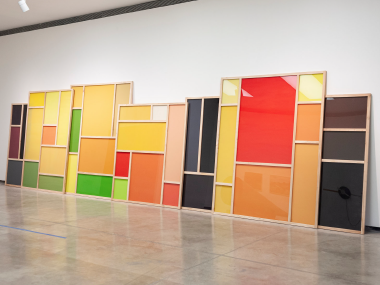 Dolores Zinny & Juan Maidagan. Campo Inmediato, 2023. Vidrio, pintura acrílica, madera. 250 x 750 x 35 cm. Colección de los artistas
Dolores Zinny & Juan Maidagan. Campo Inmediato, 2023. Vidrio, pintura acrílica, madera. 250 x 750 x 35 cm. Colección de los artistas
Dolores Zinny & Juan Maidagan
The artist duo Dolores Zinny & Juan Maidagan, who have been based abroad for 30 years, present a new version of a project originally created in 2002. The artwork, consisting of a wooden structure and 78 glass panels, was originally hand-painted with three or four shades of green, a kind of illusory garden that engaged with the architectural space. On this occasion, Campo inmediato has been invaded by the colors of fire, intentionally displacing the greenish tones. A direct reference to drought and heat: "We thought about those aerial maps used to represent graphs of desertification, and being from Santa Fe, we couldn't create a garden with very green tones... Now, by a conjecture, we find ourselves looking at this piece after 30 years, at that time the vision of minimalism and modernism was different."
Gallery 4
The works of Silvia Gurfein, Mariela Scafati, Elena Dahn, and Andrés Aizicovich oscillate between painting and sculpture, form and concept, contemplation and performativity. Their approaches involve a reflection on art, its present and history, its formats and materialities, evading local marks. These are pieces that could be found anywhere in the world… or could they not? More elements for speculative debate.
Silvia Gurfein creates her works using the remnants of oil paint left on her palettes and brushes, dried over many years. For her, these remnants connect her with the history of universal painting: it's the same material that thousands of artists have used, transcending their styles and orientations. They hold a sort of DNA of the medium. The works of Andrés Aizicovich allude to the history and tradition of sculpture, but they do so with irony and humor. Most of them use appropriated materials. His installations possess a performative character that often demands the viewer's engagement.
Mariela Scafati's work projects from the wall into space, transforming the ensemble of frames into a sort of body in suspended motion. Due to its form and dimension, it could also be conceived as an organism that both challenges and shelters the viewer's body. Elena Dahn takes the female profile as a starting point for a range of reflections, ranging from material experimentation with resins to the issue of representing the female body in art history, placing special emphasis on its virtues and complexities in the development of a woman's life.
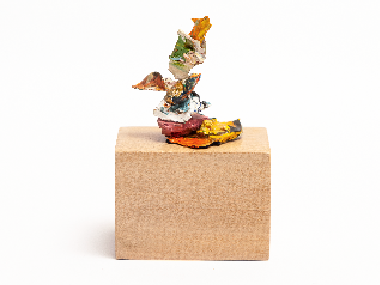
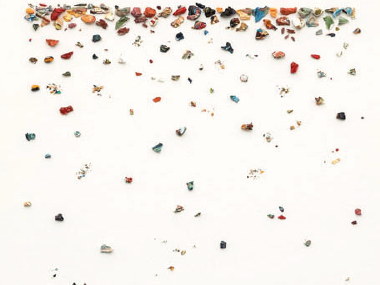 Silvia Gurfein. Il pleut V, 2023. Fragmentos de óleo y de tela sobre passepartout. 81 x 31 cm. Colección de la artista
Silvia Gurfein. Il pleut V, 2023. Fragmentos de óleo y de tela sobre passepartout. 81 x 31 cm. Colección de la artista
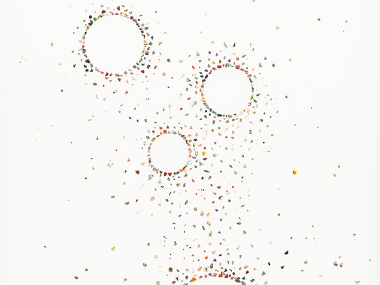 Silvia Gurfein. Supernova II, 2023. Fragmentos de óleo y de tela sobre passepartout. 102 x 81 cm. Colección de la artista
Silvia Gurfein. Supernova II, 2023. Fragmentos de óleo y de tela sobre passepartout. 102 x 81 cm. Colección de la artista
Silvia Gurfein
Artist Silvia Gurfein (Buenos Aires, 1959) creates a series of sculptures and paintings using the residue of oil paint accumulated on her working palettes. Since 2009, she releases these fragments - conceived by the artist as "splinters" of an explosion - onto canvases, accumulating them for the creation of this series of works. "I detach them, cut them, move them... they turn into a sort of precious stones, minimal units that can carry my own history, but also carry the history of art, because I maintain that oil contains it in its DNA." Her small sculptures take on the character of volume, of three-dimensional material, while her canvases house abstract compositions that manifest her interest in painting. Her work unfolds across various mediums, raising questions linked to her own history and the History of Art. Is painting done blindly, seen through the canvas? Is painting a tabula rasa? Is it writing upon writing?
"My work can be read as an extensive conversation between references to the image, always as absence, like a ghost that eludes identification, and the work with remnants, traces, what seems to have been left out of sight and discarded in the history of painting. A back and forth between accumulations of oil, pigments, and multicolored impasto, and the use of the canvas as if it were picking up the trace of an absent body: that of painting itself."
These works were exhibited in "Un cuerpo extraño en el ojo" (A Foreign Body in the Eye), Nora Fisch Gallery (2023); "Volvió el cuerpo al alma" (The Body Returned to the Soul), Smol - Camera de proyectos (2022); "Amigxs el futuro es nuestro/pintorAs 10 años" (Friends, the Future is Ours/paintorAs 10 years), Usina del Arte (2019).
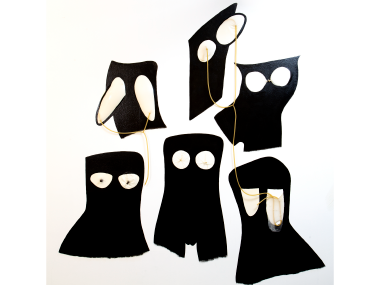 Elena Dahn. Torsos II, 2023. Látex natural sobre pared. Dimensiones variables. Colección de la artista
Elena Dahn. Torsos II, 2023. Látex natural sobre pared. Dimensiones variables. Colección de la artista
Elena Dahn
Elena Dahn's Torsos (Buenos Aires, 1980) are presented as living mural paintings that take on new forms during their activation. The artist places particular emphasis on the breast area - historically depicted by male artists for erotic purposes - which she detaches from the wall to represent the different stages this part of the body goes through. This motif of representation, present from ancient times to modernity, "fills with air and empties, stretches almost to the point of breaking," describes the artist. In her works, there is a constant reference to the body - both one's own and others' - and its transformation; in this sense, natural latex is conceived as if it were skin, a metaphor for the permeability between Dahn and the world.
"The image of my work is constantly transforming, it can start with a tiny pinch on the wall and end with a fairly large blister. It can become something that I can use to insert my body into, to discharge a certain mood of the day. In a way, it's a membrane that receives my relationship with the world."
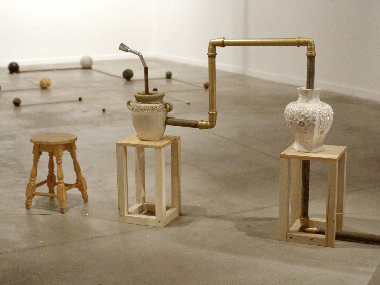 Andrés Aizicovich. La Voz del Interior, 2016. Vasijas de diversos materiales (cemento, porcelana, barro), tuberías de hierro, flor de ducha, bocina de fonógrafo, madera. 70 x 60 x 300 cm. Colección del artista
Andrés Aizicovich. La Voz del Interior, 2016. Vasijas de diversos materiales (cemento, porcelana, barro), tuberías de hierro, flor de ducha, bocina de fonógrafo, madera. 70 x 60 x 300 cm. Colección del artista
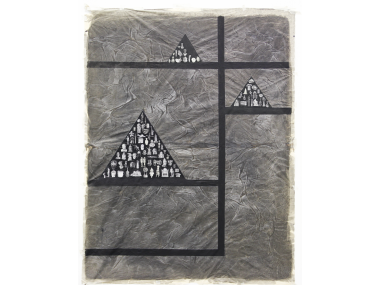 Andrés Aizicovich. Sin título (Recursos Humanos), 2015. Acrílico y collage sobre papel. Díptico, 150 x 90 cm c/u. Colección del artista
Andrés Aizicovich. Sin título (Recursos Humanos), 2015. Acrílico y collage sobre papel. Díptico, 150 x 90 cm c/u. Colección del artista
Andrés Aizicovich
Language, communication, oral transmission, conversation, and translation are some of the concepts revisited by Andrés Aizicovich (Buenos Aires, 1985) in his works. The machines and objects selected for La Voz del Interior (The Voice from Within) are associated with relational connections and encounters between individuals. The voice, which travels through these ducts and objects that make up the artwork, is conceived as a sculptural tool and action of a bond. Words serve as activators of the world, regulators of relationships, and therapeutic methods. The vases metaphorically reconstruct their own history - one belonging to the artist's grandparents, another to their parents, and one to the artist - connecting the three generations through a duct.
The work Sin título (Recursos Humanos) presents a pyramid scheme upon which images of sculptures from various pre-Columbian cultures and heterogeneous images cut from inherited encyclopedias are distributed. The arrangement's order seems to suggest an incomprehensible logic, an unthinkable classification; erasing symbolic associations and homogenizing hierarchies.
The artist envisions his productions as a sort of social laboratory in which all participants intervene simultaneously, a social construct built like a swarm of intelligences that often culminate in an artistic object. How can speech be transformed into material? How can words become an artistic medium? How can oral communication be engaged beyond the language governed by words?
"I am interested in thinking of the artist as an idealistic inventor, capable of creating technologies that propose a transformation of the material and poetic conditions of the world. My objects and installations seek to reinvent the dynamics of communication and offer new forms of encounter."
These works were exhibited in "La voz del interior" (The Voice from Within), Centro Cultural Recoleta (2016).
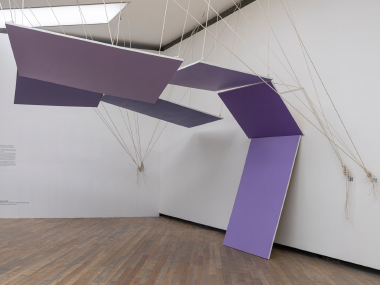 Mariela Scafati. La potencia y una silla más o menos intacta, 2022. Acrílico sobre tela, sogas y poleas. 400 x 446 x 400 cm. Colección de la artista y Galería Isla Flotante
Mariela Scafati. La potencia y una silla más o menos intacta, 2022. Acrílico sobre tela, sogas y poleas. 400 x 446 x 400 cm. Colección de la artista y Galería Isla Flotante
Mariela Scafati
In artist Mariela Scafati's investigations (Buenos Aires, 1973), color assumes a central role. Painting becomes an arena, a territory where her activist work and the intensity of color converge.
A sequence of violet-dyed canvases, suspended by pulleys, displays different gradations of violet, a firmament, a refuge in motion, a supported and suspended structure. The heritage of Malevich's monochrome and Klein's blue monochrome is present, but enriched by her own volumetric singularity. Through provocative questions, Scafati poses inquiries that problematize painting as a traditional medium: Does a painting acquire characteristics of a body when it becomes an object? To what extent can a painting sustain its state? The notion of conceiving painting hung upside down, suspended from the ceiling like an extended panorama composed of diverse monochromatic paintings is revived.
A constant in Mariela Scafati's work is the question about the limits of painting, or more precisely, how and to what extent it's possible to push and stretch the boundaries of the medium. The title of this piece, La potencia y una silla más o menos intacta, is a sort of poetic turn that emphasizes the potentiality of the pictorial and its intrinsic sensory capacity.
